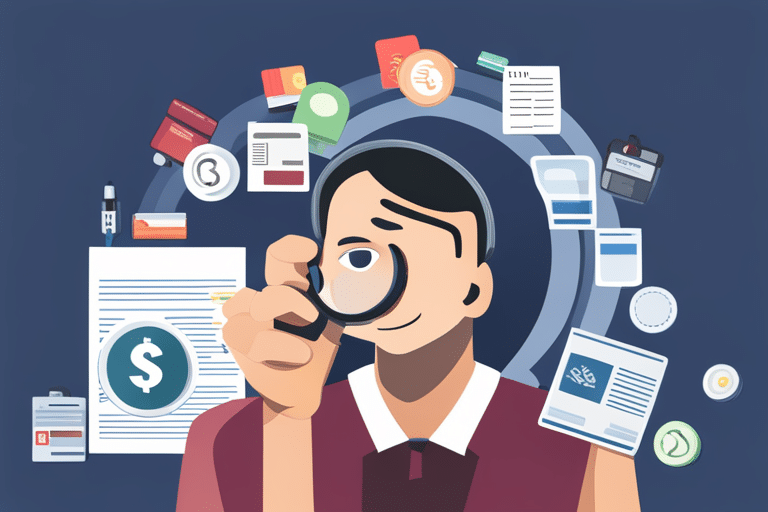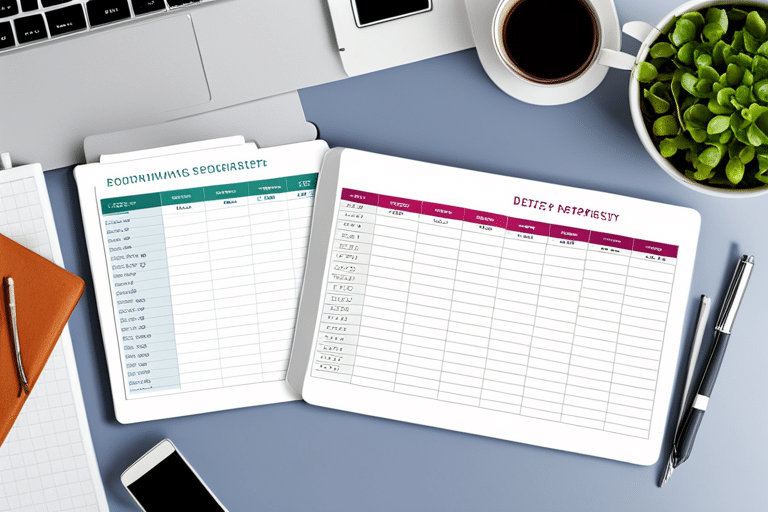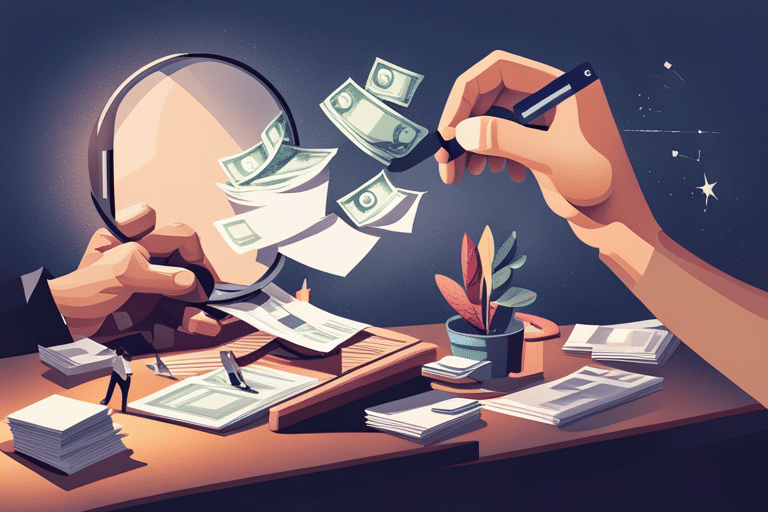Hey there, debt conqueror! Ready to take charge of your financial situation and bid farewell to those pesky debts? Well, look no further because this article is your secret weapon.
We’ll guide you through the ins and outs of prioritizing and tackling your debts efficiently, helping you regain control over your money.
From understanding your debt situation to negotiating with creditors and exploring consolidation options, we’ve got you covered.
So grab a pen and get ready to become a master in the art of debt repayment!
Key Takeaways
- Analyze your debt situation and identify the amount owed and interest rates.
- Evaluate each expense to determine its necessity and look for areas to save money and reduce expenses.
- List debts in descending order based on interest rates and explore options for lower interest rates.
- Choose a prioritization technique that resonates with personal preferences and emphasize the importance of finding a strategy that works for individual circumstances.
Understanding Your Debt Situation

You need to take a closer look at your debt situation and understand the amount you owe and the interest rates attached to each of your debts. It’s time to face the music, my friend.
Grab a cup of coffee, sit down with your laptop, and let’s dive into this debt-filled adventure together.
First things first, credit counseling can be your secret weapon in this battle against debt. These experts will analyze your financial situation and help you come up with a plan to tackle your debts efficiently. They’ll guide you through the maze of interest rates and repayment options like a wise old wizard leading you to victory.
Next up is debt settlement – a term that might sound intimidating but fear not! It simply means negotiating with creditors to settle your debts for less than what you owe. Think of it as haggling at a flea market, except instead of getting an antique lamp for half its price, you’re reducing the burden on your shoulders.
Understanding these concepts is crucial because once you have all the facts in front of you, it becomes easier to prioritize which debts should be tackled first. So gather all those bills, sharpen your pencil, and let’s embark on this journey towards financial freedom!
Assessing Your Income and Expenses

Assessing your income and expenses is crucial in order to effectively manage and reduce your debt. It’s like taking a good look at yourself in the mirror before going out on a hot date. You want to know where you stand financially so you can make a plan to tackle those debts head-on.
To assess your financial health, start by listing down all your sources of income – be it from your job, side hustles or even that lucky scratch-off ticket you won. Next, write down all your monthly expenses – from rent and groceries to Netflix subscriptions and that gym membership you barely use (come on, we’ve all been there).
Now let’s get nested with some bullet points:
- Take a careful look at each expense and ask yourself: ‘Is this really necessary?’ If not, consider cutting back or eliminating it altogether.
- Look for areas where you can save money. Maybe you can switch to a cheaper phone plan or brew coffee at home instead of splurging on expensive lattes every day.
By assessing your income and expenses, you’ll be able to determine how much money you have available each month to put towards paying off debt. This will help you create an effective timeline for repayment.
Speaking of repayment timelines, let’s move on to the next section about identifying high-interest debts…
Identifying High-Interest Debts

Hey, you savvy money manager!
Let’s dive into the exciting world of interest rates and debt prioritization techniques. Buckle up because we’re about to assess those sneaky high-interest debts lurking in your financial closet.
With a fun mix of number crunching and strategic planning, we’ll help you prioritize your debts like a pro and say goodbye to those pesky interest charges.
Get ready to take control of your finances with a dash of flair!
Interest Rate Assessment
When prioritizing and tackling your debts efficiently, it’s important to consider the interest rates. These rates can have a big impact on how quickly you pay off your debts and how much money you ultimately save.
To effectively assess the interest rates of your debts, follow these steps:
- Start by gathering all the necessary information about each debt, including the current balance and the interest rate.
- Make a list of all your debts in descending order based on their interest rates.
- Highlight any high-interest debts that are costing you a significant amount of money.
- Look for opportunities to find lower interest rates, such as balance transfer offers or refinancing options.
Finding lower rates can help reduce the overall cost of your debts and make them more manageable. So, take some time to compare different interest rates and explore options for lowering them.
You’ll be one step closer to mastering your finances!
Debt Prioritization Techniques
To effectively manage your debts, it’s crucial to consider different techniques for prioritizing and tackling them. Two popular methods are the debt snowball and the debt avalanche. Let’s break it down in a fun way with a handy table:
| Technique | Description |
|---|---|
| Debt Snowball | Start by paying off your smallest debts first, regardless of interest rates. |
| This method gives you quick wins and boosts motivation along the way. | |
| Debt Avalanche | Focus on paying off debts with the highest interest rates first. |
| You’ll save more money in the long run, but it may take longer to see progress. |
Now that you know these techniques, choose which one resonates with you the most. Remember, there’s no right or wrong answer here – what matters is finding a strategy that works for you and helps you gain control over your debts like a boss!
Creating a Budget and Savings Plan

You should start by analyzing your expenses and income to create a budget and savings plan that will help you tackle your debts efficiently. Budgeting is like going on a financial diet, but without giving up pizza (because let’s be real, who wants to give up pizza?). It’s all about finding the right balance between spending and saving so you can pay off those pesky debts.
To get started, here are some budgeting strategies to consider:
- Categorize your expenses: Break down your spending into different categories like groceries, entertainment, and bills. This will help you see where your money is going and identify areas where you can cut back.
- Set realistic goals: Be honest with yourself about how much you can save each month. It’s better to start small and gradually increase your savings than to set unrealistic expectations and end up feeling discouraged.
Now that you have a budget in place, it’s time to think about emergency fund planning. Life has a way of throwing unexpected curveballs at us (like accidentally dropping our phone in the toilet), so having an emergency fund is crucial. Aim to save at least three to six months’ worth of living expenses in case of any unforeseen circumstances.
Developing a Debt Repayment Strategy

Now that you have a budget and emergency fund in place, it’s time to develop a strategy for paying off your debts. But don’t worry, tackling your debt can be as fun as sliding down a snow-covered hill on a winter’s day!
One popular method is the debt snowball method. It’s like building a snowball from scratch and watching it grow bigger and bigger as you roll it down the hill. Start by listing all your debts from smallest to largest, regardless of interest rates. Pay the minimum on all of them except the smallest one. Throw any extra money you have towards that small debt until it’s completely gone. Then, take the amount you were paying towards that small debt and add it to the minimum payment of your next smallest debt. Keep repeating this process until all your debts are paid off!
If you prefer a more strategic approach, consider using the debt avalanche strategy. Picture yourself standing at the top of a mountain covered in snow, ready to ski down while avoiding avalanches along the way. With this method, list your debts from highest to lowest interest rate. Focus on paying off the debt with the highest interest rate first while making minimum payments on other debts. Once that high-interest debt is eliminated, move onto the next one.
Negotiating With Creditors and Lenders

When negotiating with creditors and lenders, it’s important to be assertive and communicate your financial situation clearly. Remember, you hold the power here! So, put on your negotiation hat and let’s dive in.
Here are a couple of tips to help you negotiate settlements like a pro:
-
Be prepared: Gather all the necessary documents, such as account statements and payment history. This will show them that you mean business.
-
Offer what you can afford: Start by proposing an amount that is within your means. If they refuse, don’t panic! Negotiate for a lower settlement or suggest a payment plan instead.
Now, let’s talk about debt settlement companies. While they may promise to magically make your debts disappear, proceed with caution! Here are some things to keep in mind:
-
Research thoroughly: Look for reputable companies with positive reviews. Check if they are accredited by organizations like the American Fair Credit Council.
-
Understand the costs involved: Debt settlement companies often charge fees for their services. Make sure you understand how much it’ll cost you before signing any agreements.
Exploring Debt Consolidation Options

So, you’re thinking about exploring debt consolidation options?
Well, buckle up because we’re about to dive into the pros and cons of this financial adventure.
We’ll also explore the best consolidation methods out there and how they can impact your oh-so-important credit score.
Trust me, by the end of this discussion, you’ll be armed with all the knowledge you need to make an informed decision that suits your unique situation.
Pros and Cons
One important aspect to consider when prioritizing and tackling your debts efficiently is weighing the pros and cons. Debt consolidation can be an attractive option, but it’s essential to understand both sides of the coin before making a decision.
Pros:
– Simplified payments: Consolidating your debts allows you to combine multiple payments into one, making it easier to manage and stay organized.
– Potential savings: If you can secure a lower interest rate through debt consolidation, you could save money in the long run.
Cons:
– Extended repayment period: While consolidating your debts may lower your monthly payment, it often extends the overall repayment period.
– Possible fees: Some debt consolidation options come with fees or charges that can eat into any potential savings.
Best Consolidation Methods
Consolidating your debts using one of the best methods can help simplify your payments and potentially save you money in the long run. Now, let’s dive into the world of debt consolidation and explore some amazing benefits it brings to the table!
First off, by consolidating your debts, you’ll only have to worry about a single monthly payment instead of multiple ones. It’s like having a personal assistant who takes care of all those pesky bills for you! Plus, with just one payment to keep track of, you’ll have more time for fun things like binge-watching your favorite shows or perfecting that new recipe.
But wait, there’s more! Debt consolidation can also help reduce your interest rates. Imagine paying less each month and watching those savings pile up. It’s like getting a discount on that designer bag you’ve been eyeing!
Now, let’s talk alternatives to debt consolidation. If you’re not ready to commit or want to explore other options, consider negotiating with your creditors directly or seeking advice from credit counseling agencies. Remember, knowledge is power when it comes to tackling debt.
Impact on Credit Score
If you’re considering debt consolidation, it’s important to know that it can have an impact on your credit score. Don’t worry though, it’s not all doom and gloom! Here’s the lowdown on how debt consolidation affects your credit.
-
Credit Utilization: Debt consolidation may actually help improve your credit utilization ratio. This is the percentage of available credit you’re using at any given time. By consolidating multiple debts into one, you can lower your overall credit utilization, which looks good to lenders.
-
Credit History: Debt consolidation can also affect the length of your credit history. If you close old accounts after consolidating them, it could shorten the average age of your accounts. However, if you keep those accounts open and continue making payments on time, it can actually lengthen your credit history.
Staying Motivated and Tracking Progress

Staying motivated and tracking your progress is crucial when tackling your debts efficiently. You know, it’s like climbing a mountain – you need to keep your eyes on the prize and measure how far you’ve come. It can be tough at times, but trust me, it’s worth it in the end.
Now, let’s talk about staying motivated. Debt can feel overwhelming, but remember that Rome wasn’t built in a day. Take small steps forward and celebrate each milestone along the way. Treat yourself (within reason of course) when you pay off a chunk of debt or reach a savings goal. Positive reinforcement goes a long way!
Tracking your progress is just as important as finding motivation. Keep a record of all your debts and payments so that you can visually see how far you’ve come. There are plenty of apps and tools available to help make this process easier for you.
Frequently Asked Questions
What Are Some Common Mistakes People Make When Prioritizing Their Debts?
You’re not alone, everyone makes mistakes when prioritizing debts. But beware the consequences! Neglecting high-interest debts and paying only the minimum can lead to a never-ending cycle of debt. Don’t fall into that trap!
Is It Better to Pay off Debts With the Highest Interest Rates First or Focus on Those With the Lowest Balances?
Want to pay off your debts efficiently? Should you focus on the highest interest rates or lowest balances? Well, it depends. The debt snowball method tackles low balances first, while the debt avalanche method targets high interest rates. You decide!
How Can I Negotiate With Creditors or Lenders to Lower My Interest Rates or Monthly Payments?
To negotiate with creditors or lenders and lower your interest rates or monthly payments, try these strategies: be polite but firm, explain your financial situation, propose a debt repayment plan, and consider seeking professional help if needed.
Are There Any Potential Drawbacks or Risks Involved in Debt Consolidation?
When it comes to debt consolidation, there are a couple of things you should be aware of. First off, you might end up paying more interest in the long run. Plus, your monthly payments could potentially go up. On top of that, there’s also the risk of hurting your credit score and falling victim to shady lending practices. So make sure you weigh the pros and cons before diving in!
What Are Some Effective Ways to Stay Motivated and Track Progress While Paying off Debts?
Imagine your debts as a mountain to conquer. Stay motivated by celebrating small victories along the way, like reaching each basecamp. Use progress tracking techniques such as visual charts or apps to see how far you’ve come. Keep climbing!
Conclusion
Congratulations! You’ve successfully grasped the art of prioritizing and tackling your debts efficiently. It’s like clearing the path to financial freedom, one step at a time.
Picture yourself standing on top of a mountain, basking in the warm glow of accomplishment. With a little budgeting magic, negotiation skills, and determination, you can conquer any debt that stands in your way.
So keep going, my friend! Stay motivated and track your progress as you journey towards a debt-free life. You’ve got this!

